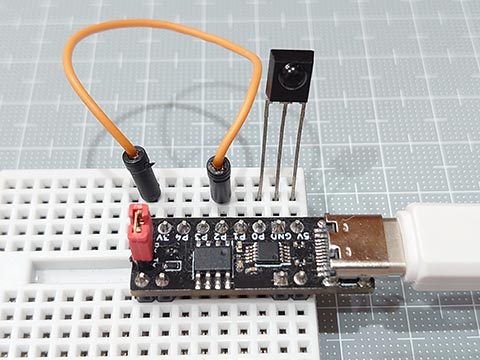202duino で リモコン信号をシリアル送信 [Arduino]
文字列と数値(n進法の整数)をシリアル出力する関数もつくって、自作シリアル送信プログラムを赤外線リモコン受信スケッチと組み合わせてみた。
赤外線リモコンの受信を簡単なスケッチで。:放課後マイコンクラブ:SSブログ
https://hello-world.blog.ss-blog.jp/2023-09-09
これと組み合わせて、、
余裕で2kBに収まりました。

赤外線リモコンの受信を簡単なスケッチで。:放課後マイコンクラブ:SSブログ
https://hello-world.blog.ss-blog.jp/2023-09-09
これと組み合わせて、、
最大2048バイトのフラッシュメモリのうち、スケッチが1576バイト(76%)を使っています。 最大128バイトのRAMのうち、グローバル変数が10バイト(7%)を使っていて、ローカル変数で118バイト使うことができます。
余裕で2kBに収まりました。

// IR Receive and Decode
#define IR_IN 0 // IR Receiver pin
#define TX 2 // Serial TX pin
#define BAUD 9600 // baud rate
void setup() {
pinMode( TX , OUTPUT ); // Tx pin
pinMode( IR_IN , INPUT ); // input Vout(active low, negative logic)
}
void loop() {
uint32_t irData = 0;
uint8_t irProtocol = 0, irBit = 0, irArray[20] = {0};
// ****** Receive and Decode IR signals ******
uint16_t us = pulseIn( IR_IN, LOW , 65535 ); // Judge the protocol by the length of the leader section (usec.)
if ( us > 2000 && us < 3000 ) { // *** SIRC ***
irProtocol = 'S'; // T=600us, ON/OFF : leader= 4T/1T, 0=1T/1T, 1=2T/1T
for(;(us = pulseIn( IR_IN, LOW , 3000 )); irBit++)
if( us > 1000 && us < 1500 ) irData |= (1UL << irBit);
}else if( us > 3500 && us < 5000 ) { // *** AEHA ***
irProtocol = 'A'; // T=425us, ON/OFF : leader= 8T/4T, 0=1T/1T, 1=1T/3T, stop=1T
while( digitalRead( IR_IN ) );
for(;(us = pulseIn( IR_IN, HIGH, 4000 )); irBit++)
if( us > 1050 && us < 1500 ) irArray[ irBit / 8 ] |= (1 << (irBit % 8) );
}else if( us > 7200 && us < 11000 ) { // *** NEC ***
irProtocol = 'N'; // T=560us, ON/OFF : leader=16T/8T, 0=1T/1T, 1=1T/3T, stop=1T
while( digitalRead( IR_IN ) );
for(;(us = pulseIn( IR_IN, HIGH, 3000 )); irBit++)
if( us > 1350 && us < 2000 ) irData |= (1UL << irBit);
}else return;
// ****** Display results by protocol ******
serialPrintStr( irProtocol == 'S' ? "SIRC: " : irProtocol == 'A' ? "AEHA: " : "NEC : " );
if( !irBit ) {
serialPrintStr( " (repeat code) \n" );
return;
}
serialPrintNum( irBit, DEC );
serialPrintStr( "bit" );
if( irProtocol == 'A' ) {
for( uint8_t i = 0; i < ( (irBit + 7) / 8 ); i++ ) {
serialPrintStr((irArray[i] < 0x10) ? " 0x0" : " 0x" );
serialPrintNum( irArray[i], HEX );
}
} else {
serialPrintStr( " 0x" );
serialPrintNum( irData, HEX );
serialPrintStr( "\t0b" );
serialPrintNum( irData, BIN );
}
serialPrintStr("\n");
}
void inoTX( uint8_t c ) { // *** OK up to 19200bps at 20MHz(ATtiny202) ***
digitalWrite( TX, LOW ); // start bit
delayMicroseconds( 1000000 / BAUD );
for(uint8_t i = 0; i < 8; i++ ) { // data bits
digitalWrite( TX, ( c >> i ) & 1 );
delayMicroseconds( 1000000 / BAUD );
}
digitalWrite( TX, HIGH ); // stop bit
delayMicroseconds( 1000000 / BAUD );
}
void serialPrintStr( const char *str ) {
for( ; str[0]; str++ ) inoTX( str[0] );
}
void serialPrintNum( uint32_t num , uint8_t N ) {
uint8_t n[32], dig = 0;
do { n[dig++] = num % N; } while( num /= N );
for( ; dig; ) inoTX( "0123456789ABCDEF"[ n[--dig] ] );
}
// Uses less RAM, but requires more flash memory and calculations
void serialPrintNum2( uint32_t num , uint8_t N ) {
uint32_t t = num, pwr = 1;
for( ; t /= N ; pwr *= N );
for( ; pwr ; pwr /= N ) inoTX( "0123456789ABCDEF"[ (num / pwr) % N ] );
}
2023-09-17 00:32
nice!(0)
コメント(0)




コメント 0